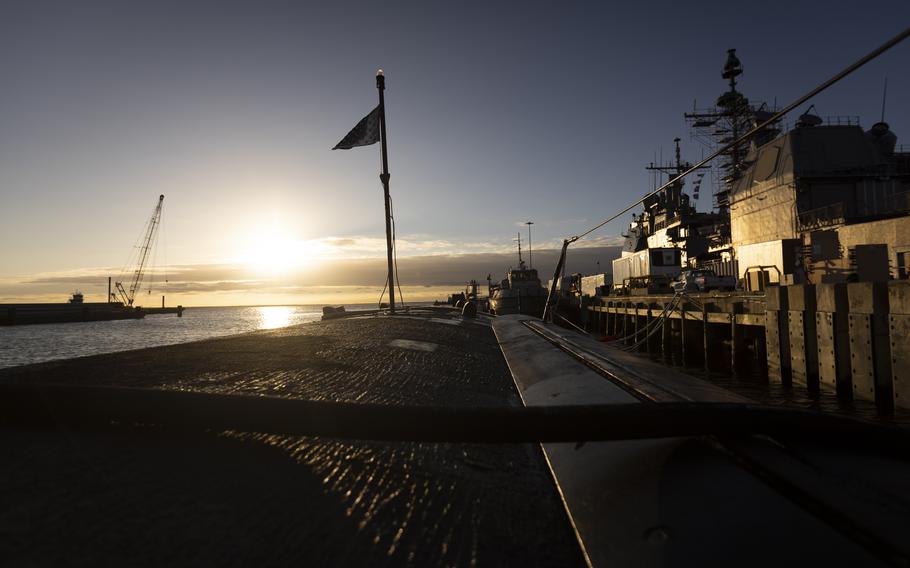
The sun sets on the USS Pasadena at Naval Station Norfolk on Jan. 31, 2024. The USS Pasadena, a Los Angeles-class fast attack submarine, is undergoing a scheduled maintenance at Naval Station Norfolk, Va. (Billy Schuerman, The Virginian-Pilot/TNS)
NORFOLK, Va. (Tribune News Service) — Plastered on plaques, chair covers, and tabletops aboard the USS Pasadena is a decorative crest reminding the submarine’s sailors of their mission: “anytime, anywhere.”
“We are like ninjas,” Lt. j.g. Judner Attys said with a smirk.
The USS Pasadena, a Los Angeles-class fast attack submarine, is undergoing a scheduled maintenance pierside at Naval Station Norfolk. It is one of about 60 active U.S. Navy submarines around the world.
Capable of operating for months from the deep, these submersibles are seldom seen once they dive, resurfacing only for supplies.
What allows the Pasadena, as well as every submarine in the Navy’s fleet, to live up to the “anytime, anywhere” motto is the ability to be self-sufficient. This includes making its own fresh water and oxygen for the 140 sailors on board.
“Every time we make the decision to surface, we are saying, ‘Here we are,’ ” said Senior Chief Petty Officer Eddie Murray, the master chief of the Pasadena’s engineering department.
In July, the Pasadena made national headlines for stopping at the U.S. naval base at Guantanamo Bay around the same time a Russian naval vessel arrived at Havana’s port. The Cuban Foreign Ministry called the Pasadena’s visit a “provocative escalation,” ABC News reported.
Self-sufficiency, Murray said, can be the difference between life and death for the entire crew.
Submarines use reverse osmosis for production of fresh water. The process is identical to that of coastal towns, with the only difference being powered by the nuclear energy of a submarine, Murray said.
Reverse osmosis works by bringing in seawater from the ocean and pressurizing it to remove salt and other contaminants. The water produced by submarines, Murray said, is the “purest water.”
“The only way to get fresher water would be like in Iceland and Greenland, straight from a glacial source,” Murray said.
The water is tested weekly to ensure it’s safe for the crew to drink. The water is also used for plumbing. Just as important, if not more important, is a submarine’s ability to create its own oxygen.
“It is just like how you make air at your house for tools, like with a little air compressor,” Murray said. “The only difference is ours is a little bit bigger and goes up to higher pressure.”
Submarines make air using electrolysis, which splits water molecules to produce hydrogen and oxygen. The hydrogen is put back into the ocean while the oxygen is stored in tanks aboard the submarine.
“Sustainability is what allows us to be anywhere, anytime, in any given situation,” Attys said.
Invisibility is vital for submarine missions. According to the Department of Defense, submarines are tasked with anti-surface and antisubmarine warfare, intelligence gathering, mine reconnaissance, land attacks, polar operations, Special Forces support and defending other fleet ships.
As supply officer aboard the Pasadena, Attys said he is responsible for optimizing “every little inch” of the 362-foot submarine to ensure it surfaces when leadership wants it to — not when it is forced to because it is low on supplies.
“We are the tip of the spear,” Attys said. “Adversaries know we are out there but they can’t guess when or where we will pop up.”
caitlyn.burchett@virginiamedia.com
©2023 The Virginian-Pilot.
Visit pilotonline.com.
Distributed by Tribune Content Agency, LLC.